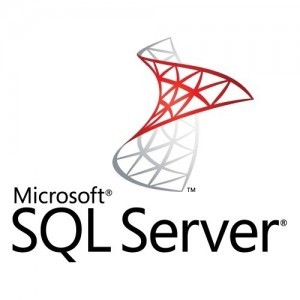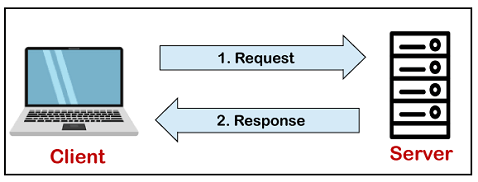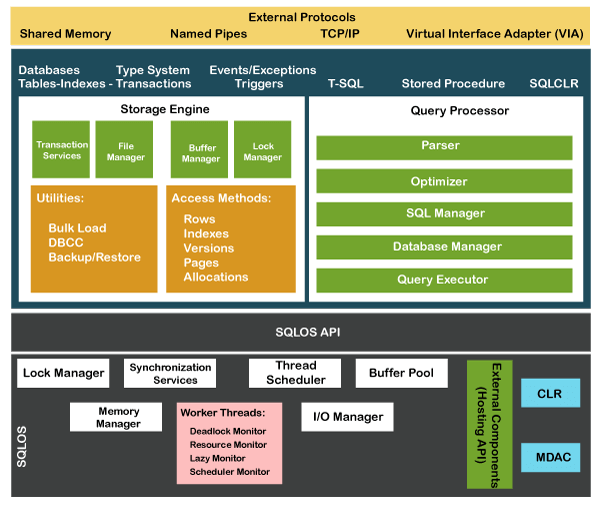SQL Server Tutorial

SQL Server Tutorial provides basic and advanced concepts of SQL Server. Our SQL Server Tutorial is designed for beginners and professionals both.
SQL Server is software (A Relational Database Management System) developed by Microsoft. It is also called MS SQL Server. It is implemented from the specification of RDBMS.
Our SQL Server Tutorial includes all topics of SQL Server such as SQL Server tutorial with SQL Server, install visual studio, install SQL Server, architecture, management studio, datatypes, db operations, login database, create database, select database, drop database, create table, delete tabel, update table, min function, max function, sum function, sql operators, advance operator, clauses, create view, keys constraints and indexes, primary keys, foreign keys,indexes etc.
What is SQL Server?
The relational database management system (RDBMS) is a Microsoft software product mainly used to store and retrieve data for the same or other applications. We can run these applications on the same computer or a different one.
Microsoft developed and marketed the SQL Server relational database management system (RDBMS) to primarily compete with the MySQL and Oracle databases. It is also called MS SQL Server, which is an ORDBMS, platform-dependent, and can work on GUI and command-based software. The key interface tool for SQL Server is SQL Server Management Studio (SSMS), which operates in both 32-bit and 64-bit environments.
If we want to understand the SQL Server completely, we must first learn the SQL language. SQL is a query processing language used for dealing with data in relational databases. According to the client-server model, a database server is a computer program that provides several services for our database to other programs or computers. As a result, we referred to a SQL Server as a database server that uses SQL as its query language.
Microsoft SQL Server comes in several versions, each corresponding to various workloads and demands. The data center edition is optimized for higher application support and scalability levels, while the Express edition is a free, scaled-down version of the software.
Usage of SQL Server
The following are the key usage of MS SQL Server:
- Its main purpose is to build and maintain databases.
- It is used to analyze the data using SQL Server Analysis Services (SSAS).
- It is used to generate reports using SQL Server Reporting Services (SSRS).
- It is used to perform ETL operations using SQL Server Integration Services (SSIS).
Version History of SQL Server
SQL Server's journey began on June 12th, 1988, when Microsoft joined Ashton-Tate and Sybase to develop a new variant of Sybase SQL Server for IBM OS/2. They released the first database product named SQL Server v1.0 in 1989. The first version served as Microsoft's entry to the enterprise-level database market, competing with the MySQL, Sybase, IBM, and Oracle databases.
Microsoft retained ownership of the name SQL Server after the partnership ended in the early 1990s. Microsoft has released several SQL Server versions since the 1990s that are SQL Server 2000, 2005, 2008, 2012, 2014, 2016, 2017, and 2019.
The early versions of the MS SQL Server primarily used in departmental and workgroup applications, but later Microsoft expanded its capabilities in subsequent ones such as an enterprise-class relational DBMS. Over the years, SQL Server has integrated numerous data processing and data analytics tools and features to support emerging technologies such as the internet, cloud computing, and mobile devices.
SQL Server Editions
SQL Server comprises five editions with different bundled services and tools and pricing options to meet the user needs. Microsoft provides two editions of SQL Server free of charge, which are given below:
SQL Server Developer: This edition was released mainly for use in the non-production environment, i.e., database development and testing. It allows to build, test, and demo purpose.
SQL Server Express: It is used for small-scale applications and databases with disc storage capacities of up to 10 GB.
For commercial purposes, the following editions are used:
SQL Server Enterprise: It is used in high-end, larger, and more critical businesses. All SQL Server features, such as high-end security, advanced analytics, and machine learning, are included in this version.
SQL Server Standard: This edition is suitable for data marts and mid-tier applications that included basic reporting and analytics. It supports partial enterprise edition's feature, as well as server limitations on the number of processor cores and memory that we can configure.
SQL Server WEB: This edition is suitable for Web hosters who want a low overall ownership cost. It has features of scalability, manageability capabilities, and affordability for small to large-scale web properties.
SQL Server as Client-Server Architecture
SQL Server is based on a Client-Server Architecture and is intended for end-users known as clients who send requests to the MS SQL Server installed on a particular computer. The server will give the desired output as soon as the processing input data is requested. This server is available as a separate program and responsible for handling all the database instructions, statements, or commands. The SQL Server Database Engine, which controls data storage, processing, and security, is thus the core component of MS SQL Server.

SQL Server Architecture
The below diagram explains the basic overview of the SQL Server architecture:

SQL Server works on a client-server architecture. It looks very simple from the front end, but internally, multiple processes run in the background to fulfill this request. Based on the architecture, the SQL Server mainly has three major components:
- Network Protocols (SNI- SQL Server Network Interface)
- Database Engine
- SQLOS
Network Protocol
It is entirely responsible for the SQL Server database engine's client connectivity. For client connectivity to the SQL Server database engine. It also has one more protocol named VIA. VIA is a hardware-based protocol that is now obsolete by Microsoft. In the latest SQL Server Configuration Manager, we will not see this protocol.
It supports three primary protocols for network connectivity:
- Shared Memory: It is the simplest protocol that does not require any configuration. It works on the same system where SQL Server is installed. There is no communication between the client and the server.
- TCP/IP: This is the most commonly used client-server communication protocol. We can use the SQL Server Configuration Manager to enable it.
- Named Pipes: It is mainly used for LAN connectivity and can be enabled from the SQL Server Configuration Manager.
Database Engine
It is the core of the SQL Server architecture. It is the second layer of the architecture that provides connectivity between user connections using network protocol and SQL server operating system to perform actual execution. It shows the logical architectures of the database objects such as tables, views, stored procedures, and triggers that work with physical architecture and relation engine to fulfill client requests.
The Database Engine consists of two parts:
- Relational Engine: It is responsible for evaluating user requests and performs execution. It decides the most efficient way to run a query. It is also named the query processor. Query processing, memory management, thread and task management, buffer management, and distributed query processing are all main tasks performed by this engine.
- Storage Engine: It shows the physical database architecture, as well as data storage and retrieval from storage systems and the buffer manager.
SQL OS
It was first used in SQL 2005. Previously, it was only considered for small and medium applications. Microsoft upgrades SQL Server in SQL 2005 to accommodate high-end enterprise database load. It's a layer that lies between the database engine and the windows operating system. Many Operating system services are handled by SQLOS, including memory and I/O management, scheduling, threading, exception handling, and synchronization.
SQL Server Services and Tools
Both data management and business intelligence (BI) tools and services are included in MS SQL Server. Let us discuss them below:
SQL Server includes the following tools and services for data management:
SQL Server Integration Services (SSIS): This tool transfers various data types from one source to another through export, import, transformation, and loading. It converts raw data into information that can be used in the future.
SQL Server Data Quality Services (DQS): It creates a knowledge-based data quality product and employs it to perform data correction, enrichment, standardization, and de-duplication. We can also use it to cleanse data with cloud-based reference data services.
SQL Server Master Data Services (MDS): It is used to manage a master set of the organization's data. It organizes the data into models, create rules for data updation, and control who updates those data.
SQL Server Data Tool (SSDT): It is a database design and development tool.
SQL Server Management Studio (SSMS): This tool allows us to manage, deploy, and monitor SQL Server databases.
SQL Server includes the following tools and services for data analysis:
SQL Server Analysis Services (SSAS): This tool is used in decision support and business analytics analytical data engine. It is designed for deeper and faster data analysis, data mining and also has machine learning capabilities. R and Python language are integrated with SQL Server for advanced analytics.
SQL Server Reporting Services (SSRS): It has decision-making capability as well as a set of tools and services for creating, deploying, and managing reports. Hadoop is integrated with this tool.
SQL Server also has the following essential components:
SQL Server: It enables us to starts, stops, pauses, and continues the MS SQL Server instance.
SQL Server Agent: It works the same as the task scheduler in the computer system. We can use this whenever we need it.
SQL Server Browser: It receives the user's request and connects to the appropriate SQL Server instance.
SQL Server Full-Text Search: Full-text search searches all document keywords that may or may not exactly match the search criteria. It enables the user to run full-text queries against character data in tables.
SQL Server VSS Writer: It is used when the SQL Server is not running to backup and restore data files.
SQL Server Instances
An instance is the installation of SQL Server. We can install several instances on a particular machine, but only one can be the default. It is an exact copy of the server files, databases, and security credentials.
SQL Server is divided into two types:
Primary Instances: We can access the primary instance in two ways. The first is by using the server name, and the second is its IP address. It is always unique.
Named Instances: We can access it by appending a backslash and instance name.
For example, suppose we want to connect with an instance named xxx on the local server, we need to use 127.0.0.1\xxx. On a server running SQL Server 2005 or later, we can run up to 50 instances at the same time.
Advantages of SQL Server Instances
The following are advantages of SQL Server instance:
- Installation of different versions on one machine
It allows us to install multiple versions on a single computer, each of which operates independently of the others. - Cost Reduction
It helps in reducing the operating costs of SQL Server. We can get different services from different instances, so we don't have to buy a single license for anything. - Maintain production, development, and test environments separately
The key advantage of running multiple versions of SQL Server on a single computer is that you can distinguish your development, output, and test environments separately. - Reduce temporary database problems
If we run all services on a single SQL Server instance, there is a high risk of having problems. We can avoid such issues if they run on different instances. - Separate security privileges
When different SQL Server instances run different services, it is easy to concentrate on securing the instance that runs the most sensitive service. - Maintain a standby server
If the SQL Server instance fails, it can result in a service outage. It explains the importance of having a backup server available to take over in the event when the primary server fails. This feature makes it simple to accomplish with SQL Server instances.
Prerequisite
Before learning SQL Server, you must have the basic knowledge of Basic SQL and MySQL.
Audience
Our SQL Server Tutorial is designed to help beginners and professionals.
Problem
We assure that you will not find any problem in this SQL Server tutorial. But if there is any mistake, please post the problem in contact form.
Posted by: darlenedarlenedaitonowe0266419.blogspot.com
Source: https://www.javatpoint.com/sql-server-tutorial